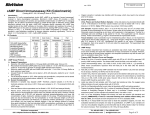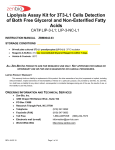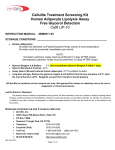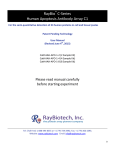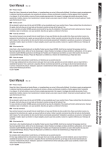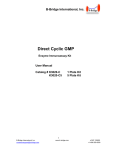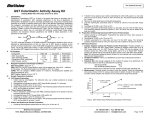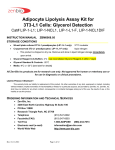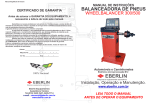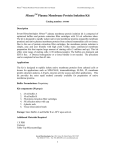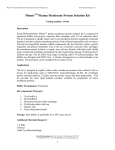Download cGMP Direct Immunoassay Kit (Colorimetric)
Transcript
BioVision rev. 08/14 cGMP Direct Immunoassay Kit (Colorimetric) (Catalog #K372-100; 100 assays; Store at -20°C) I. II. Introduction: Adenosine and guanosine 3’,5’-cyclic monophosphate (cAMP and cGMP) are important “second messengers” involved in many physiological processes. BioVision’s cGMP Direct Immunoassay Kit provides a direct competitive immunoassay for sensitive and quantitative determination of cGMP level in biological samples. The kit utilizes the recombinant Protein G coated plate to anchor cGMP polyclonal antibody. cGMP-HRP conjugates directly competes with cGMP from samples for binding to the cGMP specific antibody on the plate. After incubation and washing, the amount of cGMP-HRP bound to plate can easily be determined by reading OD450 nm. The intensity of OD450 nm is inversely proportional to the concentration of cGMP in samples. The kit provides a new acetylation procedure that improves detection signal significantly. The kit can detect 0.04 -10 pmol/well (0.008 - 2 µM) cGMP samples. Kit Contents: Component 10X cGMP Assay Buffer Standard cGMP (10 nmol) Neutralizing Buffer Acetylating Reagent A Acetylating Reagent B* Anti-cGMP pAb/BSA cGMP-HRP/BSA HRP Developer Protein G Coated Plate III. K372-100 100 assays 25 ml 1 vial 7.5 ml 0.75 ml 1.5 ml 1 vial 1 vial 10 ml 1 each Color Code Cap Color Storage Temperature Part Number WM Yellow NM Violet Black Red Green Amber ---- +4°C K372-100-1 K372-100-2 K372-100-3 K372-100-4 K372-100-5 K372-100-6 K372-100-7 K372-100-8 6522-1 -20°C +4°C +4°C +4°C -20°C -20°C +4°C -20°C cGMP Assay Protocol: A. Reagent Preparations: Dilute the 10X cGMP Assay Buffer to 1X Assay Buffer with MilliQ water. Store at 4 °C. Reconstitute the Standard cGMP (pellet may not be visible) in 1 ml of 0.1M HCl (not provided), vertex for 10 seconds to generate 10 pmol/µl cGMP stock standard solution. Reconstitute rabbit anti-cGMP pAb and cGMP-HRP each with 1.1 ml of the 1X Assay Buffer as stock solutions. Unused well strips can be kept at –20°C with the desiccants, stable for up to 1 month. The kit should be stored at –20°C. After reconstitution, some components may be stored at 4°C as instructed above, stable for up to 1- 2 months. *NOTE- Acetylating Reagent B is very volatile and hence the vial has to be tightly capped and stored only at +4°C. B. General Consideration: cGMP samples in 0.1 M HCl (final concentration) is stable and can be used directly in the assay. Make dilutions of your sample with 0.1 M HCl to the range of 0.04-10 pmol/well (0.008-2 µM). Plasma, serum, whole blood, and tissue homogenates often contain phosphodiesterases and large amount of immunoglobulins (Igs) which may interfere with the assay. However, preparing samples in 0.1 M HCl can generally inactivate phosphodiesterases and lower the concentration of Igs, making the samples suitable for the assay. Both phosphodiesterases and Igs can also be removed by 5% TCA precipitation or by using 10 Kd molecular weight cut off microcentrifuge filters (BioVision Cat.# 1997-25). BioVision Incorporated 155 S. Milpitas Boulevard, Milpitas, CA 95035 USA For research use only To determine whether interference is presence in your sample, you may make two different dilutions. If the two different dilutions of sample show good correlation in the final calculated cGMP concentrations, purification is not required. If you do not see good correlation of the different dilutions, deproteinize the sample by using TCA or 10 Kd molecular cut off microcentrifuge filters. Some organic solvents may interfere with the assay and may need to be removed prior to the assay. C. Sample Preparation: Urine, Plasma and Culture Media: Urine, plasma, and culture media may be tested directly after adding 1/10 volume of 1M HCl, and remove precipitates if occur. Culture Cells: For suspension cells collect by centrifugation. Add 1 ml of 0.1M HCl for every 35 cm2 of surface area (e.g., 10 cm plate at 70 % confluency is ~ 110 cm 2, so use ~ 3.1 ml). Incubate at room temperature for 20 minutes on ice. For adherent cells add the HCL directly, scrape cells off the surface. Dissociate sample by pipetting up and down until suspension is homogeneous. Transfer to a centrifuge tube and centrifuge at top speed for 10 min. The supernatant can be assayed directly. Protein concentration >1 mg/ml is recommended for reproducible results. Tissue Samples: Cyclic nucleotides may be metabolized quickly in tissue, so it is important to rapidly freeze tissues after collection (e.g., using liquid nitrogen). Weigh the frozen tissue and add 5-10 volume of 0.1M HCl. Homogenize the sample on ice using a Polytron-type homogenizer. Spin at top speed for 5 min and collect the supernatant. The supernatant may be assayed directly. D. cGMP Assay Protocol: Prepare cGMP Standard Curve and Samples: 1. Add 200 µl of the 10 pmol/µl standard cGMP stock into 800 µl of 0.1M HCl to generate 2 pmol/µl cGMP working solution. The diluted cGMP should be used within 1 hour. 2. Label 11 microcentrifuge tubes, 10, 5, 2.5, 1.25, 0.625, 0.3125, 0.156, 0.078, 0.039, 0, 0_B pmol/50 µl. (Note: these concentrations represent what will finally be in the wells after the dilutions mentioned below). 3. Add 200 µl of the 2 pmol/µl cGMP into the tube labeled 10 pmol (enough for 20 tests), add100 µl 0.1M HCl into the rest of tubes. 4. Transfer 100 µl from the 10 pmol tube into the labeled 5 pmol tube, mix. Continue the serial dilution by transferring 100 µl from the 5 pmol tube to 2.5, 1.25, 0.625, 0.3125, 0.156, 0.078, 0.039 pmol tubes. Discard 100 µl from the 0.039 pmol tube. The diluted cGMP should be used within 1 hour. 5. Label new tubes for test samples, add 100 µl each test sample per tube. We suggest using different dilutions for each sample (dilute with 0.1M HCl). 6. Add 50 µl of Neutralizing Buffer to each tube to neutralize the HCl in the samples and standards. 7. Prepare Acetylating Reagent Mix (Note: 5 µl is needed for each assay): Mix 1 volume of Acetylating Reagent A (Violet cap) with two volumes of Acetylating Reagent B (Black cap) in a microtube. Prepare just enough for the experiment. Use within 1 hour. 8. Add 5 µl of the Acetylating Reagent Mix directly into each test solution (both standard and sample), IMMEDIATELY vortex 2-3 seconds following each addition without delay, one tube at a time and incubate at room temperature for 10 min. 9. Add 845 µl 1X Assay Buffer into each tube, mix well. Use for below quantification. Note: The acetylation step improves the assy sensitivity significantly and avoid the interferences of many components in unpurified samples. (If cGMP in your samples are very low, the acetylation reagents can be dried after step 8, without dilution step 9 to minimize the volume. Then reconstituted in a 50 -100 µl volume of Assay Buffer). Tel: 408-493-1800 | Fax: 408-493-1801 www.biovision.com | [email protected] Page 1 of 2 BioVision Quantification cGMP: 1. Add 50 µl of the acetylated Standard cGMP and test samples from Step 9 above to each well of the Protein G coated 96-well plate. We suggest duplicate assays for each sample and standard. 2. Add 10 µl of the reconstituted cGMP antibody per well to the standard cGMP and sample wells except the well with 0_B pmol cGMP. (Note: Do not add cGMP antibody into the well with 0_B pmol cGMP, instead add 10 µl of 1X Assay Buffer for background reading). Incubate for 1 hour at room temperature with gentle agitation. Note: Using a repeating pipette is recommended for minimizing pippetting errors. 3. Add 10 µl of cGMP-HRP to each well and incubate for 1 hr at room temperature with gentle agitation. 4. Wash 5 times with 200 µl 1X Assay Buffer each time. Completely empty the wells by tapping the plate on a fresh paper towel after each wash step. 5. Add 100 µl of HRP developer and develop for 1 hour at room temperature with agitation. 6. Stop the reaction by adding 100 µl of 1M HCl (not provided) to each well (sample color should change from blue to yellow). 7. Read sample at OD 450 nm. 8. Subtract OD450 nm background reading (the well with 0_B pmol cGMP) from all samples and standards. Plot standard curve to observe the linear portion, then replot only the linear portion and in Excel add a trendline, then use the trend line linear formula (y=mx+b). Calculate amount of cGMP in samples after correcting the for dilution factors. 9. Calculations: C = Sa/Sv pmol/µl or nmol/ml or µM. Where: Sa is the cGMP amount (pmol) from the Standard Curve. Sv is the sample volume (µl) added into the assay wells after dilution factor correction. cGMP Standard Curve: The assay was performed following the kit protocol rev. 08/14 For research use only RELATED PRODUCTS: Apoptosis Detection Kits & Reagents Annexin V Kits & Bulk Reagents Caspase Assay Kits & Reagents Mitochondrial Apoptosis Kits & Reagents Apoptotic DNA Ladder Detection Kits TUNEL-based DNA Fragmentation Assay Kits Apoptosis Inducers and Set Cell Fractionation System Mitochondria/Cytosol Fractionation Kit Nuclear/Cytosol Fractionation Kit Membrane Protein Extraction Kit Cytosol/Particulate Rapid Separation Kit Mammalian Cell Extraction Kit FractionPREP Fractionation System Cell Proliferation & Senescence Quick Cell Proliferation Assay Kit Senescence Detection Kit High Throughput Apoptosis/Cell Viability Assay Kits LDH-Cytotoxicity Assay Kit Bioluminescence Cytotoxicity Assay Kit Live/Dead Cell Staining Kit Cell Damage & Repair HDAC Fluorometric & Colorimetric Assays & Drug Discovery Kits HAT Colorimetric Assay Kit & Reagents DNA Damage Quantification Kit Glutathione & Nitric Oxide Fluorometric & Colorimetric Assay Kits Signal Transduction cAMP & cGMP Assay Kits Akt & JNK Activity Assay Kits Beta-Secretase Activity Assay Kit Obesity Research Recombinant Adiponectin, Survivin, & Leptin CETP & PLTP Activity Assay & Drug Discovery Kits Cholesterol and HDL/LDL Quantification Kits Fatty acid and Triglyceride Quantification Kits NAD(P)/NAD(P)H and ADP/ATP Assay Kits Antibodies & Recombinant Proteins (many) Adiponectin Proteins & Antibodies C5a Recombinant Protein Protein G & Protein A Bulk Quantity Growth Factors, Cytokines & Chemokines Antibodies to Apoptosis & Cell Signaling Molecules Metabolism Assay Kits Cholesterol Assay Kit HDL/LDL assay kit Glucose Assay Kit Lactate Assay Kit Pyruvate Assay Kit NAD(P)H/NAD(P) Assay Kit Glutathione Assay Kit Nitric Oxide Detection Kit FOR RESEARCH USE ONLY! Not to be used on humans. BioVision Incorporated 155 S. Milpitas Boulevard, Milpitas, CA 95035 USA Tel: 408-493-1800 | Fax: 408-493-1801 www.biovision.com | [email protected] Page 2 of 2


